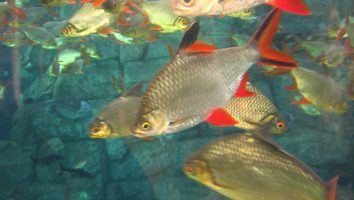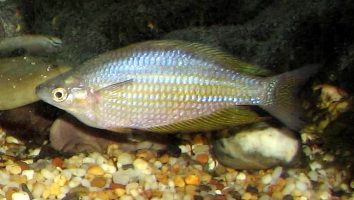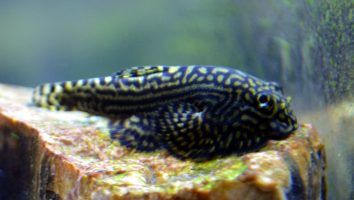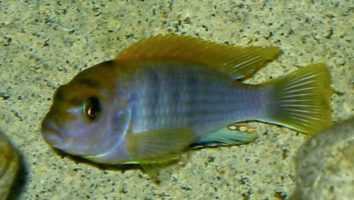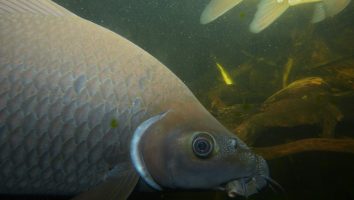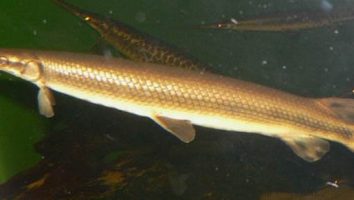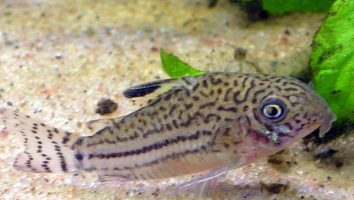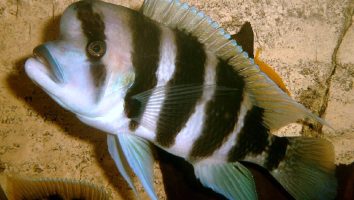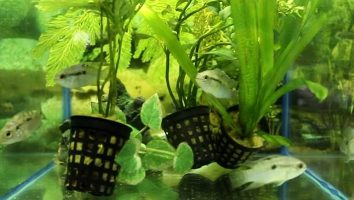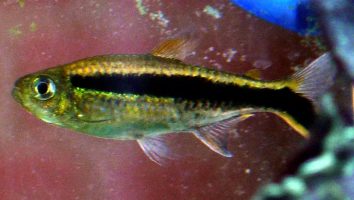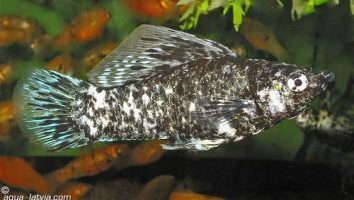The empire gudgeon is a freshwater fish that is native to Australia. They are a peaceful community fish that can be a great addition to any aquarium.
This guide will teach you everything you need to know about empire gudgeon care. You’ll learn about their diet, size, lifespan, and more!
Table of contents
Species overview
The empire gudgeon (scientific name: Oxyeleotris cylindrica) is a type of freshwater fish that’s native to Australia and New Guinea.
They are a bottom-dwelling fish that prefers to live in slow-moving water with plenty of vegetation. This could be in the form of a river, lake, or swamp.
Empire gudgeons are very peaceful fish that get along well with other tank mates. They are known to be particularly compatible with other gudgeons.
One of the most popular things about empire gudgeons is their unique appearance. They have a long, slender body with a bright orange stripe running along their sides.
Appearance

The first thing you’ll notice about this freshwater fish is their coloration. These guys are quite colorful for such a small fish. They have a light brown body with black spots that are dotted all over.
The spots on their sides are actually in the shape of a chain that extends from the gill cover all the way back to the base of their tail.
This chain is a bit more prominent on males than females. The fins on this species are all translucent with a bit of black coloration on the tips.
The dorsal fin is short and triangular in shape. It starts about halfway back on the body and has a slight curve to it.
The anal fin is about the same size and shape as the dorsal fin. The caudal fin is forked and fairly long in comparison to the rest of the fish.
Empire gudgeons have a long and thin body shape that’s slightly flattened from top to bottom. This gives them a bit of a snake-like appearance.
Lifespan
The average lifespan of an empire gudgeon is around 2 to 3 years. However, there have been some reports of these fish living for up to 5 years in captivity.
As with any fish, the lifespan of an empire gudgeon can be greatly impacted by the level of care they receive. Things like water quality, diet, and tank mates can all play a role in how long they live.
Size
The average size of a full-grown Empire gudgeon is about 3 inches long. These fish are relatively small, so they don’t need a ton of space to move around and be comfortable.
Tank
Tank Size
The minimum tank size for empire gudgeons is 10 gallons.
Ideally, you should have a 20 gallon tank or larger if you want to keep a school of these fish. These fish are very active and need plenty of space to swim.
Water Parameters
The empire gudgeon is a peaceful and social fish that does best in a group. They are an excellent addition to a community aquarium and get along well with other peaceful fish.
As with all fish, providing empire gudgeons with the proper water conditions is essential to keeping them healthy and happy.
Water parameters can vary somewhat depending on the particular fish, but in general, you should aim for the following:
- Water temperature: 72 to 82 degrees Fahrenheit
- pH levels: 6.5 to 7.5
- Water hardness: 2 to 12 dGH
- Alkalinity Levels: 4-8 dKH
What To Put In Their Tank
When it comes to setting up an aquarium for this species you don’t need to go overboard. They’re not too fussy when it comes to the substrate, so a classic gravel should work just fine.
We recommend including some plants in their habitat as well. These fish love to hide and are very shy, so the more places they have to do that the better.
We also recommend adding a few pieces of driftwood or some larger rocks. These can provide some cover for them and make the inside of the tank look a bit more natural.
One thing to avoid is anything that’s too small. These fish are known to eat smaller fish, so anything that can fit in their mouths is likely to become a snack.
Common Diseases
These fish are actually quite hardy and don’t fall ill very often. However, there are still a few diseases that you should be on the lookout for.
The most common disease that affects this species is ich. This is a parasitic illness that will present itself as white spots on the body of your fish.
If left untreated, ich can be fatal. However, it is fairly easy to treat if you catch it early.
Another disease to look out for is hole-in-the-head disease. This is another fairly common freshwater disease that can affect a variety of different species.
This disease is caused by poor water quality and the presence of activated carbon in the tank. It will present itself as one or two pits/holes in the skin of your fish’s head.
While it is curable, it will usually leave some scarring on your fish.
The best way to prevent these diseases is to simply maintain the quality of the water in your tank. A tank with clean and stable water conditions is always less likely to cause disease in your fish.
Behavior & Temperament
The Empire gudgeon is a schooling fish, so it does best when it’s kept in groups. They are peaceful fish that get along with other tank mates, although they may nip at the fins of longer-finned fish.
Empire gudgeons are active fish that spend a lot of time swimming around the tank. They are curious creatures that like to explore their surroundings.
Empire gudgeons are not aggressive fish, but they can be territorial. They will defend their territory if they feel like it’s being threatened.
Tank Mates
The empire gudgeon is a peaceful fish that does well in community tanks. They’re not fussy about water conditions and can get along with most species.
These fish are also small, so they’re not a threat to other tank mates. In fact, they might even become prey if you’re not careful.
Some good tank mates for empire gudgeons include:
- Neon Tetras
- Guppies
- Platies
- Mollies
- Swordtails
- White Cloud Mountain Minnows
- Dwarf Gouramis
- Harlequin Rasboras
Breeding
Empire gudgeons are easy to breed in captivity. All you need is a pair of healthy adults and a suitable breeding tank. These fish don’t have any specific breeding requirements, so you can set up the tank however you want.
The only thing to keep in mind is that these fish are known to be aggressive during spawning. It’s best to remove any other fish from the tank before breeding.
Empire gudgeons typically lay their eggs in caves or other hiding places. The female will lay around 200-300 eggs at a time. Once the eggs are laid, the male will fertilize them and then guard them until they hatch.
The eggs will hatch in about a week. The fry will be extremely small, so you’ll need to feed them live foods. Baby brine shrimp or microworms are good options.
As the fry grow, you can start to introduce other foods. pellets or flakes will do. Just make sure that the food is small enough for them to eat.
Conclusion
The empire gudgeon is a great fish for beginners and experienced fish keepers alike. They’re easy to care for and don’t require much in the way of maintenance.
They’re also a very attractive fish, which is always a bonus.
If you’re looking for a fish that is low-maintenance and will add some beauty to your tank, the empire gudgeon is a great choice!

